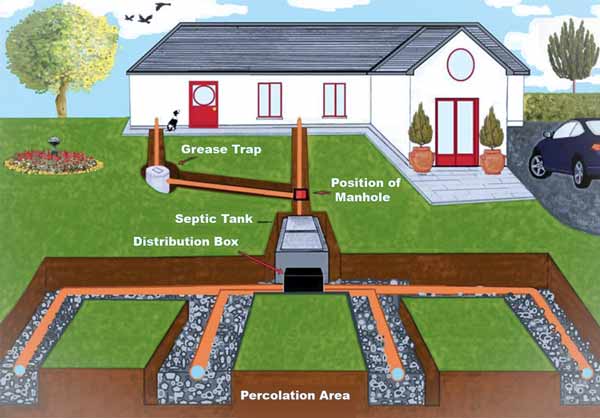If you have a septic tank on your property, knowing the dos and don’ts of driving over it is crucial. Can you drive vehicles over your buried septic tank or not? What are the risks and is it ever safe? This guide will cover everything you need to know about driving over septic tanks.
The Risks of Driving Over a Septic Tank
In most cases, driving over a septic tank is not recommended because of the potential hazards:
-
Collapsing the septic tank – Driving over an unreinforced concrete or corroded steel tank could cause it to cave in.
-
Damaging the piping – Weight can crush inlet/outlet pipes if they aren’t strengthened.
-
Blocking access – Tanks need to be accessible for pumping and repairs.
-
Contaminating soil – A damaged tank could leak sewage and contaminate soil.
-
Risking injury – Someone could fall into a collapsed tank, which is often fatal.
Unless specially designed for traffic, septic tanks are usually unable to withstand the thousands of pounds of force from a vehicle driving over them.
Is Driving Over the Septic Tank Ever Safe?
It is possible to drive over a septic tank safely if the system was specially designed and constructed for vehicle traffic:
-
Traffic-rated septic tank – With reinforced walls and lid.
-
Protected piping – Inlet/outlet pipes must be heavy duty.
-
Accessible covers – Allow service and pump outs.
-
Proper installation – Following all codes for traffic loads.
-
Qualified engineer – Gets approval for the traffic rating.
However, retrofitting an existing system can be difficult and expensive. It’s best to avoid driving over tanks not designed for traffic.
Signs Your Septic Tank Can’t Handle Traffic
-
Concrete lids – Unless steel reinforced, likely not traffic-rated.
-
Sheet metal lids – Prone to rust and collapse.
-
Brick or block tanks – Can crumble under heavy loads.
-
Plastic tanks – Not intended for traffic without engineering.
-
Unknown age or materials – No way to verify strength.
If unsure, have a pro inspect the tank construction before driving over it. Never assume safety.
What About Driving Over Septic Piping?
Buried septic pipes connecting the home to the tank and drain field are also not made to withstand heavy traffic loads. Normal plastic piping can be easily crushed.
-
Schedule 40 plastic – Standard but prone to crushing.
-
Cast iron piping – More durable but still risky.
-
Schedule 80 plastic – Upgraded for more protection.
-
Sleeved piping – Extra sleeves add strength.
Pipes must be rated for traffic, sleeved, or protected to avoid damage from vehicles.
3 Big Risks of Driving Over a Septic Tank
1. Tank Collapse
The top or sides of a septic tank can collapse if a heavy vehicle drives over it. This leads to:
- Expensive repairs or full replacement
- Sewage backups into the home
- Possible contamination leaks
Reinforced concrete or properly designed plastic tanks avoid collapse.
2. Sewage Contamination
If a tank or pipes break from traffic, raw sewage can leak out and contaminate soils.
- Health hazards from bacteria and viruses
- Groundwater pollution
- Foul odors
Avoid driving over tanks to prevent cracks and leaks.
3. Risk of Falling In and Drowning
If a septic tank lid collapses from traffic above, it creates a dangerous hole.
- Risk of falling into the tank
- Confined spaces make exit difficult
- Fatal drowning can occur quickly
Inspect covers regularly and keep people and vehicles away from questionable lids.
Tips for Safely Driving Near a Septic System
- Locate the tank and mark its location
- Keep vehicles away from tank area
- Never drive over questionable covers
- Have reinforced risers/lids installed
- Upgrade to traffic-rated tanks if needed
- Avoid tank area when ground is wet
- Inspect covers and risers routinely
- Watch for signs of trouble like odors
Signs of Septic Tank Damage from Traffic
Call a septic pro immediately if you notice:
- Cracks or leaks around tank
- Collapsed or damaged risers
- Settling or depressions in soil
- Plumbing backups
- Gurgling drains
- Sewage odors
Don’t delay – have any damage inspected and repaired promptly.
When to Call a Professional
Consult an engineer about traffic load capacities if:
- You don’t know your tank’s traffic rating
- The tank appears unreinforced or deteriorated
- You need to drive heavy vehicles over the tank
- There are signs of damage after driving over tank
Never take risks with an unknown or questionable septic tank. Calling a pro is wise.
Key Takeaways About Driving Over Septic Tanks
- Avoid driving over the tank unless it is rated for traffic loads.
- Septic piping also needs protection from heavy vehicles.
- Collapse, contamination, and injuries are risks of driving over tanks.
- Special engineering is required for traffic-rated tanks.
- Immediately repair any damage or signs of trouble.
- When in doubt, call a professional for assistance.
Knowing the limitations of your septic system prevents costly damage and dangerous mishaps. Use extreme caution when driving vehicles anywhere near your buried septic tank.
